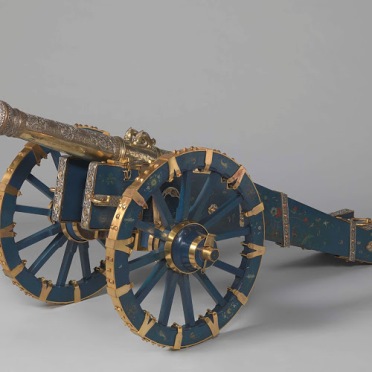Righting the historical wrong
Retrieving historical artefacts from former colonial masters
By P. K. Balachandran
COLOMBO – On Tuesday (13), Reuters reported from Amsterdam that a beautiful ornate cannon, painted in blue and gold, which had been taken away by the Dutch from Kandy in 1765 could be brought back to Sri Lanka, at least for display, in 2021.
This is part of a gathering movement in both ex-colonial countries and countries which were once colonized, to settle the question of historical artefacts seized by the conquerors and shipped to their metropolises in Europe from the 17th to the 19th Centuries.
Rijksmuseum’s Head of History, Valika Smeulders has said the museum had at least 4,000 objects in its collection from the Dutch empire that spanned three centuries from the mid-17th Century onwards, welcoming plans by the Dutch government to “right the historical wrong”.
The Dutch moves to return seized art run in parallel with similar initiatives in France and Germany, all broadly following the 1998 ‘Washington Principles’.
In 1975, Hemasiri de Silva, the then director of the National Museum of Colombo, published a catalogue of objects that were taken out of the island. The British were the most avid gatherers of Lankan cultural property, wrote Dr. Nazeema Kmaradeen of the Department of Commercial Law at the Colombo University in her 2017 paper on the subject. “Cultural objects from Sri Lanka could be found in over 16 museums in England. The objects in British hands accounted for about half the entire catalogue and numbered well over 3,000. They included statues, coins, ivories, personal ornaments, utensils, boxes, weapons, musical instruments, toys, paintings, masks, manuscripts, and textiles,” she wrote.
In 2010, Sri Lanka made an official request to various countries and private collectors to return cultural and religious artefacts and statues taken away in colonial times. Among the artefacts sought were the 16th century ivory casket intricately designed with scenes of ancient Lanka (at the Kunsthistorisches Museum in Vienna); an ivory and gold chest with rubies and sapphires embedded in it depicting events from the time of the last Buddhist emperor (Munich Museum in Germany); the bronze figure of a seated Buddha (Royal Scottish Museum in Edinburgh); an ivory cabinet with figures of Adam and Eve engraved during the Dutch period (Victoria and Albert Museum in London); a bronze figure of Avalokiteswara (Cleveland Art Museum in the US); and the Tara Devi (Pattini) statue (British Museum).
According to Prof. Kamardeen, the prized 1.43-metre-high statue of Tara, dating back to the 10th Century, was taken out of the Trincomalee-Batticaloa area in 1830 by Governor Sir Robert Brownrigg and handed over to the British Museum.
The UNESCO Convention on the Means of Prohibiting and Preventing the Illicit Import, Export and Transfer of Ownership of Cultural Property (1970), tries to curb trafficking in valuable artefacts. Sri Lanka, Portugal, the Netherlands, and the UK are parties to the convention, which mandates State parties to help each other recover and return stolen property when requested to do so by the source country. However, the convention only covers the movement of objects after 1970, and therefore, does not have any bearing on objects taken during the colonial era, Kamardeen points out.
The UNIDROIT Convention on Stolen or Illegally Exported Cultural Objects (1995) provides a maximum time limit of 50 years for the return of a cultural object from the date its location and possessor become known.
The Antiquities Ordinance (1940) provides for the preservation of antiquities, sites and buildings of historical or archaeological importance. However, it only contains provisions for cultural objects ‘discovered’ in Sri Lanka and not those held abroad. The Cultural Property Act No. 73 of 1988 controls the export of cultural property through a licensing scheme for those dealing in cultural property.
Sri Lanka could launch ‘cultural diplomacy’ to get its artefacts back, but some countries may resort to bargaining as they do in normal diplomacy. “For example, Belgium was willing to return objects to the Democratic Republic of Congo (DRC), provided its mineral interests in the DRC were protected!” Kamaradeen recalls.
“Cultural diplomacy efforts should be broadened to include education on the unique value of cultural objects to their countries of origin, and to begin negotiations on how these objects may be returned. In other words, states should work to show the importance of own cultural heritage in seeking restitution of stolen objects,” she suggests.
Dr. Kamaradeen urges government and civil society to work together to educate people about the cultural importance of lost property. “This will strengthen restitution efforts by increasing public awareness and pressure in host countries to return cultural objects.”
Museums abroad are concerned about demands for the return of artefacts as they could open the floodgates. In 2011, Egypt demanded the return of the bust to form part of its planned Grand Egyptian Museum, despite the ownership of the object having passed to Boston in the original division of finds. There’s the Koh-i-Noor Diamond (circa 3,000 BC), a 105-carat diamond in the possession of the British Crown Jewels despite the fact that India has demanded its return since Independence in 1947, Kamardeen points out.
UK has not responded positively to requests made by the Sri Lankan government in 1970 and again in 2013 to return property taken during the colonial era. The British Museum Act (1963) forbids the museum from disposing of its holdings, except in very limited circumstances.
To get round this problem, Kamardeen suggests a joint approach, say with India. “Both national laws (e.g. in the UK) and international law evolve as a result of normative pressure; they are not static. Sri Lanka can work with other former colonies (perhaps starting with other South Asian countries) to initiate dialogue on how existing law could evolve and potentially be changed to allow for the return of cultural objects,” she says.
-P K. Balachandran is a senior Colombo-based journalist who in the past two decades, has reported for The Hindustan Times, The New Indian Express and the Economist


